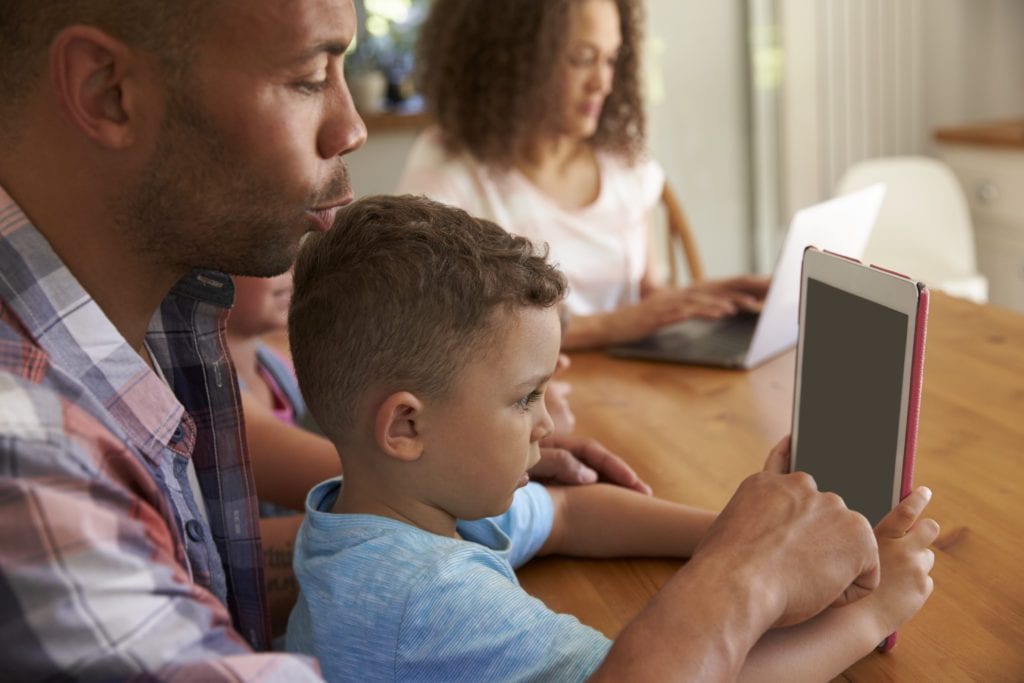Making a family media plan is a way of being proactive about the role you want digital technology to play in your family and a way of setting strategies to help you stick to it.
Modern digital media is a powerful technology that can play an essential part in the lives of individuals and families. But it can also have negative impacts if used in the wrong way, too much, or to the detriment of other healthy, fun and positive experiences. The keys to making digital technology a positive in your family life are being informed, finding a balance that works for your family and having the tools and strategies to reinforce, and sometimes enforce, good media practices.
Family Media Plan
Providing Consistent Screen Use Expectations
Every parent knows it is challenging to enforce inconsistent rules, especially the case with those involving screens. Children tend to push the boundaries and exploit loopholes every chance they get. Thankfully, a family media plan can be a lifesaver for enabling everyone to be on the same page, while spelling out clear expectations. It is a written document that outlines agreed household rules for screen use as well as consequences for breaches.
Why Screen Use Limits Matter
A 2019 report by Telethon Children's Institute's CoLab project found the rising popularity of technology use among very young children can pose considerable risks to many aspects of their development. Specifically, media used inappropriately or without thought can displace valuable activities like face-to-face interaction, family-time, outdoor-play, exercise, unplugged downtime and sleep [1].
Time Spent Online is Only One Element to Consider
These researchers found it is not just the amount of time children spend using technology that matters, but also how they use it. Young children’s use of technology needs to be actively supported and monitored by adults, who can provide learning opportunities, as well as help children to understand what they are viewing and its relevance to the world around them. Taking the time to develop a media plan ensures you think carefully about your family's technology use so it can enhance their development and learning and be a positive force in your kids' lives.
Media Planning Tools
The Online Media Plan Tool available from the American Academy of Pediatrics is an excellent tool to help you get started. The tool will help you to think about your family's media usage and to create a plan containing goals and rules that are in line with your family's values. Other resources available to guide your planning include:
- ThinkUKnow.org.au online safety contract
- Office of the eSafety Commissioner Our Family Tech Agreement (for under 5s)
- Cyber Savvy blank family agreement
- Office of the eSafety Commissioner online safety basics
- Telethon Kids Institute top tips for cyber safety
- Office of the eSafety Commissioner iParent Screen Smart Tour
What’s in a Media Plan?
Your family media plan may include agreements regarding:
- Screen-free zones in your home, e.g. bedrooms.
- Screen-free times, e.g. during dinner/one hour before bedtime.
- Device curfews, e.g. no devices after 8pm or before 7am, as appropriate.
- Safety rules, e.g. do not give out personal information online, do not use a phone while crossing a street, do not share private photos online, ask permission to download games and apps.
- Digital manners, e.g. do not look at devices while talking with someone or have it at the table during mealtime.
- Digital citizenship, e.g. respecting the privacy of others, not being rude or bullying anyone online, telling a trusted adult about messages or photos that make us uncomfortable.
- Family priorities, e.g. what chores, homework, exercise, outdoor play etc. come before screen time.
- Consequences for rule breaches.
Regardless of the contents of your particular family plan, it is essential the final agreement is clear, enforceable and works in the context of your family situation. The Telethon Institute's Cyber Savvy Project also has specific resources available for making agreements work for split families.
There is no one-size-fits-all when it comes to a family media plan. The focus should be on creating a set of rules that reflect your family's values, work within your schedules, and allow digital media to enhance your life through engagement, creativity and learning challenges. Your media plan should adapt to the changing needs of your growing family, so revisit your plan annually and adjust as required.
Remember, the most effective agreements are those where you make decisions in negotiation with your children. So spend time together talking about why a family agreement is important, making it clear that your primary concern is to help them stay healthy and safe and to have fun.
Top Tips
- A family media plan is a written document clarifying household rules for digital behaviour.
- Your plan should be unique to your values, parenting style and family situation.
- The most effective agreements are those that your children take part in negotiating
- The plan should include agreed consequences for breaches.
- Ensure the plan is simple, clear and enforceable.
- Revisit the agreement annually.
Australian National Physical Activity and Sedentary guidelines:
- Under two years old – no screen time (including watching television, electronic media, DVDs, computers and electronic games).
- 2-5 years – Less than one hour per day.
- 5-17 years – Less than two hours per day
Other Family Media Plan Resources:
- Telethon Kids Institute Cyber Savvy Project Family Agreements – The Why and How
- American Academy of Pediatrics Family Media Plan
- Raising Children Network Managing screen time: strategies for children 3-11 years
As a starting point for evidence-based recommendations on screen time limits for children of various ages, refer to the Australian National Physical Activity and Sedentary guidelines.
References
Resources
Book: ‘The Tech Diet for your Child & Teen’ by Brad Marshall
Raisingchildren.net.au: Managing screen time: strategies for teenagers

